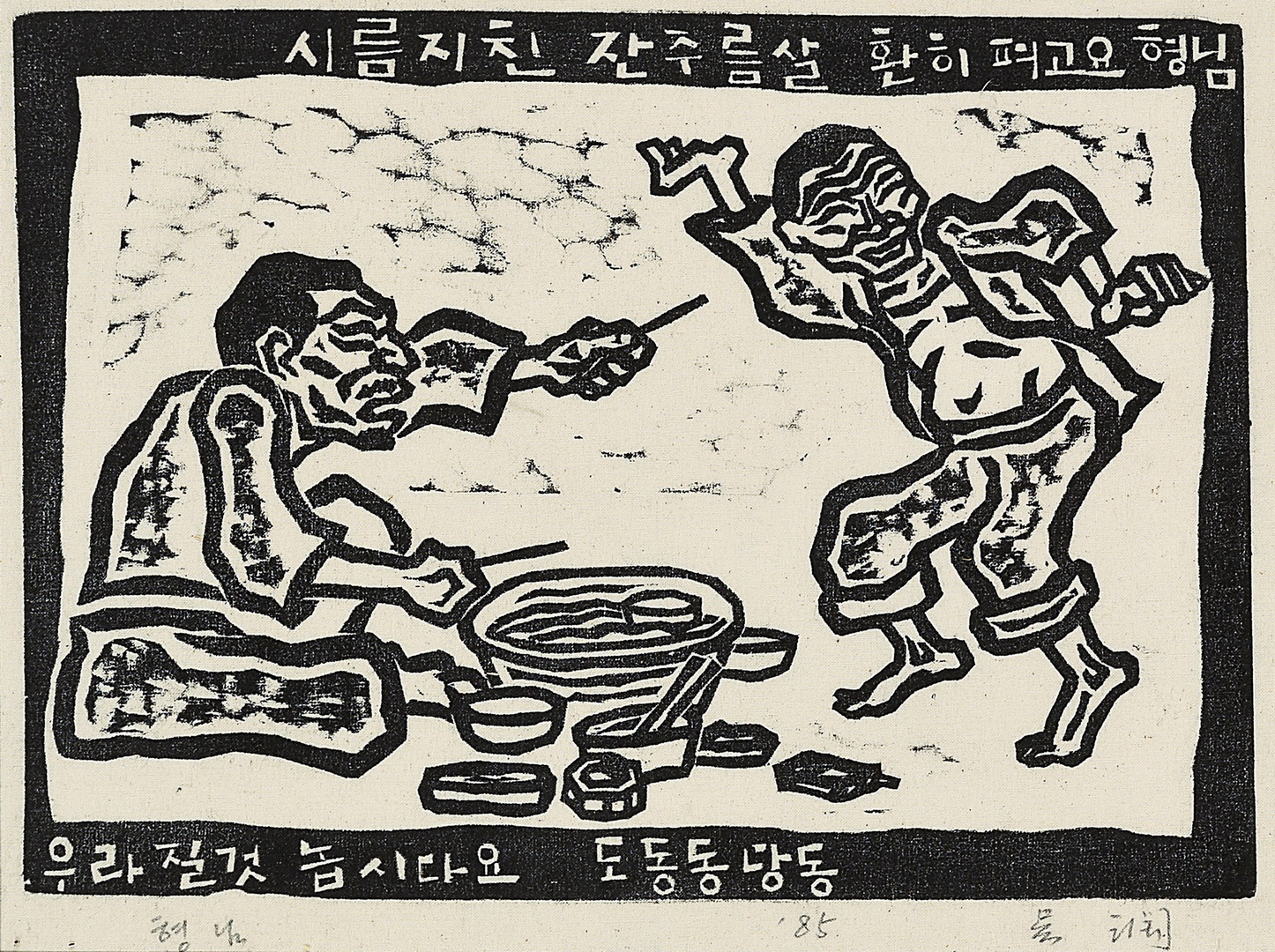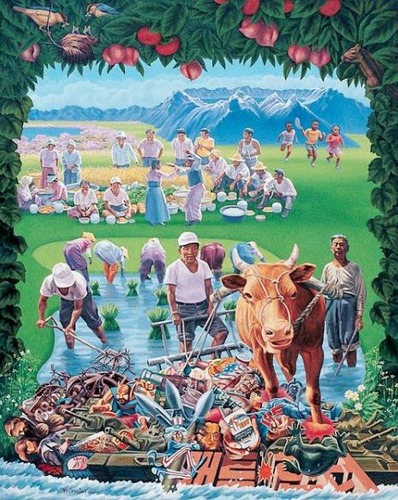Korean Art Final (copy)
1/17
There's no tags or description
Looks like no tags are added yet.
Name | Mastery | Learn | Test | Matching | Spaced |
|---|
No study sessions yet.
18 Terms
Minjung Misul ( Peoples Art 1980s)
Cultural movement (against capitalism, government, urbanization, national division, US political policy, materialism)
Popular tradition of Korea, Buddhist painting, shamanistic painting, genre painting, folk art (outdoor plays, masked dances, pansori)
Satire and Humor
Rejected Western culture and forms, seeking native traditions
Minjung Minsul Groups
Reality and Utterance (1979) The Year of Imsul (1982),
Durong (a ridge between fields)(1983), Art of Life (1984)
Minjung (common people) movement
Bottom-up democratization movement (the driving force the transition from An authoritarian military regime to a parliamentary democracy)
The 1st Minjung Group: Reality and Utterance (Hyeonsil gwa Bareon)
active from 1979-1989 (the first group)
Art critics (Sung Wankyung, Choi Min, Won Dongsuk, Yun Bommo) and artists
Reaction against and in opposition to the state-sponsored modern art (Dansaekhwa and abstract art)
2. To speak truth (reality) with art- the situation of Korean society (harsh censorship)
3. The Reality Group (Hyonsil dongin in 1969 (O Yun, O Kyounghwan, and Im Saetaek) Their manifesto was drafted by poet, Kim Chiha
its inspiration from leftist literature and advocated for (ethnic) nationalism
4. Satire and empathy: Tomiyama Taeko, Kathe Kolvits, Diago Rivera
5. Use of figuration, narrative, "low" art forms (such as billboards, magazine ads, posters, cartoons, and kitsch paintings)
O Yun,
Elder Brother,
1984,
woodblock print on paper
Influential figure of Reality and Speech Simple and undulating lines Woodblock print
Life of suppressed working class
The text which frames the scene: ‘Brother, smooth out those wrinkles Of worry and laugh it off.
Dammit! Let’s enjoy.”
Satirical comments on life condition.

O Yun,
Marketing II: Put On Your Make-up
Minjung Art, 1980
Woodblock and mixed media on canvas
Satirical comments on the growing divide Between the impoverished working class and the cash-rich urban consumer class
Lower half: a farmer, a young street vendor,
A housewife, a factory worker, and a school girl.
Upper half: a glamorous woman promotes the products The slogan “from cradle to grave” surrounds company Name ‘Ballala’ (literally ‘put it on’)
The text in the middle: ‘Beautify yourself. If you are 12, You are already woman.’----toward “Pop Art”
Marketing I-Scenes of Hell, 1980
Oil on canvas 131 × 162 cm
Coca cola, Maxim, and other Western culture Crush the sinners to death Slit their throats
Cast them into a boiling cauldron
Cut them up with a saw
The members of Reality and Speech Sung Wan-gyung, Lim Ok- sang, Yun Beom-mo, and Oh Yun Are tortured
Satire
The use of humor, irony, exaggeration, or ridicule to expose and criticize people's stupidity or vices, particularly in the context of contemporary politics and other topical issues.
Exhibition of Minjung art in America
1987 ‘Minjung Art, New Movement of Political Art from Korea’ curated by Um Hyuk in in Minor Injury gallery
1988 ‘Minjung Art: A New Cultural Movement from Korea’ in Artist Space, a non-profit art space in Manhattan.
Shin Hak-chul, Mirage, 1984, oil on canvas
Satirical comment on the government push
For modernization and an urban lifestyle
Consuming nature of the city; Class division
Mirage of a pink city of skyscrapers floats on clouds Two scantily clad women= “modern girl”
Two hot air balloons advertising “Lotte Pioneer” Banners – “payment by installment”
Contrast to rural workers
Shin Hak-chul,
Modern Korean History–Rice Planting
Minjung Art 1984 (remake of confiscated 1987) Oil on canvas, 160 x 130 cm,
Collection of the artist
The emphasis on Korean history and culture
Idyllic scene of villages with Mt. Paekdu Famers plant rice as if to signal a fertile Korea Farming----nostalgia and nationalistic pride
Foreground: a cow pulling a plough is trampling over American consumer goods
The work was regarded as praise for North Korea and confiscated and he was imprisoned for violation of the current National Security Law in 1989.

The second-generation minjung art group
Durong group (A ridge between fields)(1983)
Populist and (ethnic) nationalist aesthetic, the life of masses
2. criticize “Reality and Speech” as intellectualist depending on western forms and lack of interest in tradition
3. They more focused on Korean tradition—the root and subject of the masses create “optimistic, strong, collective spirit of sharing,” immediacy of life especially “healthy emotional living among the common people in Buddhist art, genre paintings, shaman paintings, and totem poles”
4. The most original recreation of traditional form was hanging paintings (=geolgae geurim)
Kim Bong-jun, Map of Reunification 1986, Colored woodblock print on cloth
- Founding leader of group Durong
- Easier ways to express the minjung cause
- Mask dance drama and outdoor performance
- Emulate Taengwha (large scale Buddhist hanging painting) - Banner- “reunification of the nation”
- “Poongmul” - Korean folk music instrument
(drumming, dancing, and singing)
Choi Byong-su, Yi Han-yeol, 1987
Paint on cloth, 1,000 x 750 cm,
Geolgae painting, Yonsei University, NMMC
Hanging paintings that were originally hung for worship in a large courtyard at a Buddhist temple. The term was coined by Dureong leader Kim Bong-jun, who studied taeng-hwa painting (Buddhist painting)
Film “1987” deals with the death of one student (tear gas bomb) and succeeding protest against the military dictator president Cheon Doowhan.
Hong Sung Dam, Daedong Sesang (means “the big country in the East and its world”)
The term is used since Goryeo dynasty in 16 century- national confidence and spirit May Kwangju Series print, 1984, woodblock print, private collection

Hong Sung Dum, Sewol Owol, 2014
Sinking MV Sewol ferry (the Sewol ferry disaster on April 16, 2014). Making blacklist by President Park Keunhye. 299 death 5 missing / captain and 14 crew members. A 32- foot-wide painting, which portrays, among other elements, Korean president Park Geun-hye as a maniacal scarecrow facing off against angered parents of children who died in the sinking of the MV Sewol ferry in April 2014, a national tragedy that has had huge political repercussions. Park is being held back by former president Park Chung-hee (her late father), and her chief of staff Kim Ki-choon.

Characteristic of Minjung art
Emphasized social and political subject matter and satirical criticism →realistic style so that the public could easily understand
- Influence from the folk art, Buddhist art, woodcuts, genre painting and shamanistic painting→marginalized art forms and “low” art
- Identification the collective farm culture as utopia
- The issues of Minjung art---the capitalist world order, corrupted government, the plight of farmers and city laborers, and national division, reinterpret history,
new kind of Imperialism, anti-Americanism